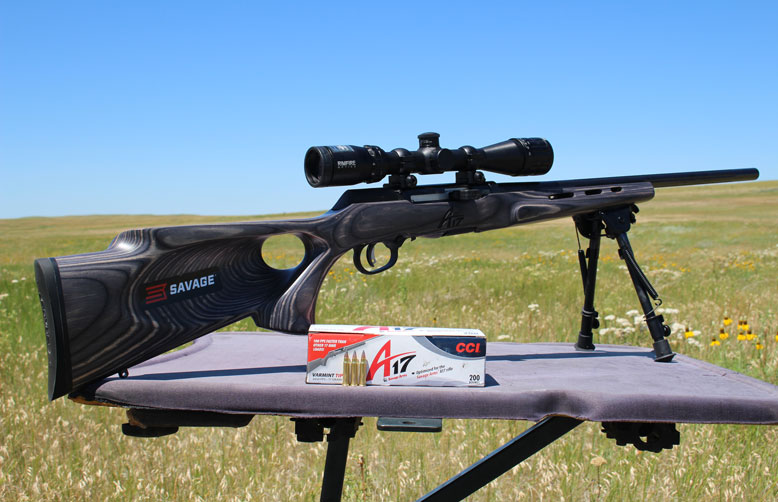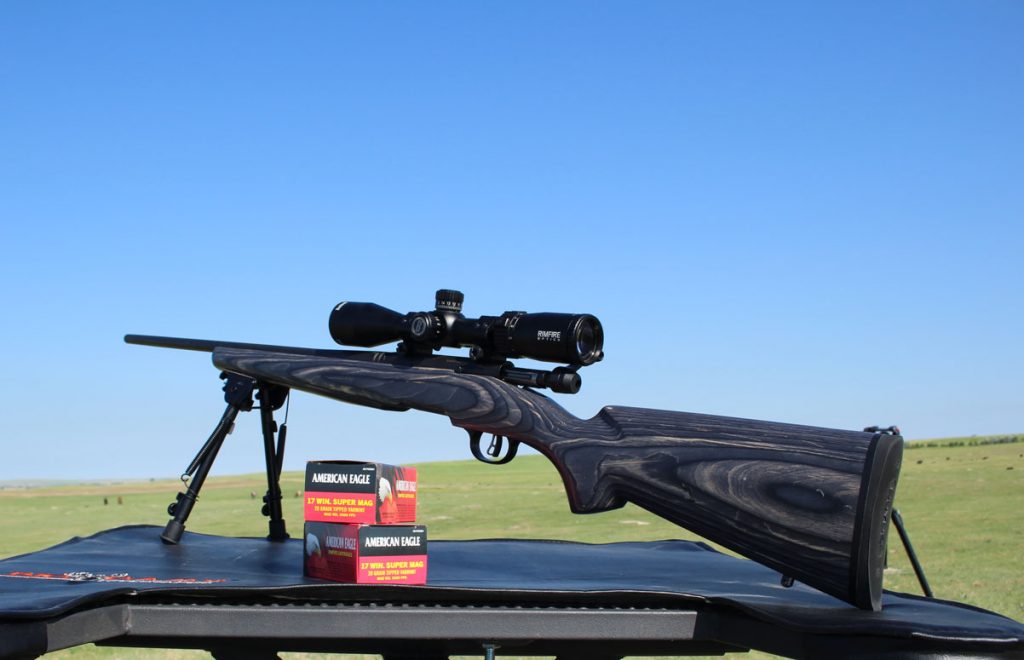Over the last 10,000 years, extreme droughts, grazing animals and fire have all helped maintain the vast prairies of South Dakota. For an Eastern U.S. hunter, staring across the arid rolling sea of grass and white limestone buttes, it’s hard to imagine how critters make a living in such a seemingly unproductive area. However, the black-tailed prairie dog has done quite well, especially on the Rosebud Indian Reservation in south-central South Dakota, which is located along the Nebraska border. Much of the Rosebud’s nearly 1 million acres is used for cattle production and with the arid climate the prairie dogs compete with the cows for food. Which opens the door for shooters to come in and help thin the population of prairie dogs.
One of the ranchers and a member of the Sioux Nation on the Rosebud, Cliff Bryan, helps guide interested prairie dog shooters on the vast reservation. I was introduced to Cliff by Jared Hinton and J.J. Reich of Vista Outdoor. Vista owns Federal Premium ammo, CCI ammo, Savage Arms, Bushnell and a plethora of other outdoor companies. They invited myself and a couple of other writers to the Rosebud to shoot 15,000 rounds of ammo through 15 rifles. While we didn’t quite burn through the 15,000 rounds of ammo, I did get to spend a tremendous amount of time behind a number of rifles while sending more than a thousand rounds of various rimfire bullets downrange.
Cliff placed us on huge dog towns where we would literally sit in one spot and shoot non-stop all day long. And because there’s nothing to stop the breeze in this part of the world, I learned a lot about “doping” the wind and rimfire performance out to 300 yards while shooting the .22 WMR, .17 HMR and the blazing .17 WSM round.
Savage A22 Magnum (.22 WMR)
At the 2016 SHOT Show Savage Arms released its new A22 Magnum semi-auto rifle chambered in .22 WMR (.22 Mag). The A22 Magnum features a 21-inch carbon-steel buttoned-rifled barrel with a satin-black finish, case-hardened receiver, hardened-chrome bolt with dual-controlled round feed and a matte-black synthetic stock. The rifle has an overall length of 40½ inches and weighs 5½ pounds. It operates with a delayed blowback action and feeds rounds via a 10-round rotary magazine. The one I used on this trip was topped with a Bushnell 3-9x40 riflescope. This rifle also comes equipped with Savage’s adjustable AccuTrigger. The entire package, minus optic, has an MSRP of $473.
As a teenager, I had a quest for a long-range squirrel rifle and bought my first .22 WMR in a bolt-action. I loved that little round for shooting unsuspecting squirrels across forested ravines in Alabama. However, on the prairie where yardage can be deceiving and the wind blows everyday, all day, the .22 WMR does have its limitations.
It wasn’t until the first afternoon that I picked up the A22 Magnum. By then the wind was blowing at a steady 15 mph and the prairie dogs in our immediate area had been worked over pretty hard. So we decided to grab the A22 Mag and a set of Primos Shooting Sticks and go on a walkabout on the other side of the hill from where we shot. As soon as we crested the hill two dozen prairie dogs scattered in all directions, madly chirping at us. Some dogs jumped in burrows while others stood straight up waiting to see which way the danger would go. I instantly set up the sticks, cradled the A22 in the rest and settled the crosshairs on a standing p-dog at 50 yards and squeezed the smooth AccuTrigger. The rodent crumbled at the report of the rifle. We continued on along the hill and I dusted another half dozen prairie dogs from 75 to 100 yards. The A22 Magnum and the .22 WMR rounds were extremely effective out to this range. However, things got a bit wobbly when trying to extinguish grass-munching varmints at 125 yards and beyond. The 15 mph winds were really pushing the bullet once beyond 125 yards and it was much harder to consistently hold windage on the small targets.
The 35-grain bullet leaves the muzzle at about 2,100 fps, but by the time it hits the 150-yard mark the bullet is slowing to subsonic levels. This would explain the maximum, consistent effectiveness in the stiff breeze out to about 125 yards. Kills dropped dramatically when we tried to hit prairie dogs at 175 to 200 yards in in this wind. With a 100-yard zero, the projectile is about 6 inches low at 150 yards as well. Easy enough to compensate on a calm day, but the stiff wind pushed the projectile all over the place at this distance and beyond.
Savage A17 Target Sporter (.17 HMR)
The next rimfire up on the prairie was the popular .17 HMR round. I’ve always been a fan of this zippy rimfire for varmint control out to 200 yards and it did its job on this trip. In 2015 Savage made headlines with the first reliable semi-auto .17 HMR. Working hand-in-hand with its sister company CCI, Savage set out to build the A17 from the ground up. With advancements in powder technology, CCI was able to ring out 100 fps more than standard .17 HMR ammo, but with a more consistent curve in pressure so that the rifle would function reliably and accurately in the delayed-blowback action.
I fired the .17 HMR rounds from Savage’s A17 Target Sporter rifle, which is the newest version of the A17. The original A17 is almost identical to the A22 mentioned above, except that it has a 22-inch barrel with a 1:9 right-handed twist. The new Target Sporter rifle features a gray laminate stock (also available in thumbhole stock), carbon-steel buttoned-rifled barrel with a satin-black finish, case-hardened receiver and a hardened-chrome bolt with dual-controlled round feed. The 10-round rotary magazine delivered good firepower on the dog towns, too. My rifle featured the Bushnell A17 Optic. Like the A22 Magnum, the A17 also features the AccuTrigger. The Sporter model has an MSRP of $571 and $631 for the thumbhole model.
The A17 was an awesome rifle to have on prairie dog towns. The semi-auto firepower was a definite advantage, especially after a close miss. The 17-grain bullet leaves the muzzle at 2,650 fps and at 100 yards is still humming along at 2,000 fps. With a 100-yard zero, the bullet was about 2½ inches low at 150 yards and about 8 to 8½ inches low at 200. Dogs within 100 yards didn’t stand a chance and wind drift was minimal. Fifteen to 20 mph winds did move the bullet by several inches out to 200 yards, but the impacts were fairly consistent so that you could figure out your windage after a few misses. The bullet is still traveling at nearly 1,400 fps at 200 yards, but beyond this range the bullet impacts were too inconsistent to accurately hit your mark. We did manage to make a few kills close to the 300-yard mark, but this had more to do with the rapid firepower and being able to “walk” the bullet into the target.
Savage B.Mag (.17 WSM)
So the question remains, is there a rimfire that offers consistent accuracy on prairie dog-sized targets out to 300 yards, even in 15 to 20 mph winds? The answer is yes, and it comes in the form of the .17 WSM.
Released in 2013, the .17 WSM is the fastest rimfire round on the market. It leaves the muzzle at a blistering 3,000 fps and carries 400 ft./lbs. of energy. On the prairie I was shooting Federal’s American Eagle, which comes in a 50-cartridge pack and sells for about $20. The 20-grain varmint tipped bullet is still clocking over 2,000 fps at 200 yards and is traveling around 1,682 fps at the 300-yard mark, while leveling prairie dogs with 126 ft./lbs. of energy.
I used a Savage B.Mag Sporter chambered in .17 WSM for my long-range dogs. The rifle featured a beautiful gray laminate stock, complete with Savage’s AccuTrigger. The Sporter models comes with a 22-inch matte-black carbon-steel barrel with a 1:9 twist and feature a rotary magazine that holds eight rounds. This rifle sells for $500. The rifle was topped with a 3-9x40 Bushnell Rimfire Optic. When sighted at 100 yards, the .17 WSM is about 4 inches low at 200 with about 7 inches of wind drift in a 10-mph crosswind and 16½ inches low at 300 with about 18 inches of wind drift. So it’s not like the bullet isn’t moving in the wind at 300 yards, but I found that it moves consistently. Meaning, once I found my correct hold over and windage, I could replicate it on other prairie dogs in the vicinity.
In one such example, I spotted a sitting prairie dog atop a mound out around the 300-yard mark. Having dusted a few dogs in this area already, I held the reticle in the same spot as before and squeezed a round off. The dog crumpled on top of the mound. While still in its death throws, another prairie dog came to investigate its comrade. I lined up on that one and fired — hit! The second dog rolled off the top of the mound. To my astonishment, another p-dog ran up onto the mound to see what was going on, and I leveled it! After later investigating the scene on foot, we ranged from the mound with the three confirmed kills back to the benches and it was 316 yards. Over the course of three days we zapped dozens of prairie dogs at and beyond 300 yards in 10- to 20-mph quartering and crosswind using the .17 WSM. It became apparent early on that the other rimfires could not compete at this distance. The only other caliber that dropped prairie dogs with consistency at this distance during our trip was a .17 Hornet, but then again, that’s not a rimfire.
If you’re interested in watching prairie dogs explode on impact, then the rimfire rounds are probably not for you, unless shooting the .17 HMR and .17 WSM at close-range targets. You won’t see the same dramatics from these tiny rounds like you will with a .22 caliber centerfire. However, there is definitely a place for the .22 WMR, .17 HMR and .17 WSM rimfire rounds on the prairie, but distance and wind will dictate which one you should go with out to the 300-yard mark.
Hunting The Rosebud
If you’re interested in stretching your rimfires or centerfires, then give Cliff Bryan a call. He has some nice dog towns to put his clients on and you can literally shoot all day long like we did. (605) 641-0073; cliftondbryan@yahoo.com.









